List of places of worship in Worthing facts for kids
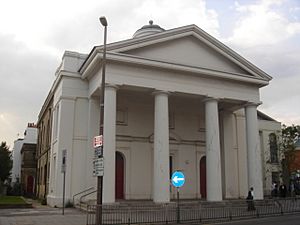
The borough of Worthing, one of seven local government districts in the English county of West Sussex, has 43 extant, operating churches and other places of worship. Twenty-one other former places of worship are still in existence but are no longer in religious use. The district, on the south coast of England, is mostly urban: it consists of the seaside resort of Worthing, established in the 19th century, and its residential suburbs, ranging from ancient villages absorbed by the growing town to housing estates built after World War II.
Although not forming a majority, the largest proportion of the borough are Christians, and there is only one non-Christian place of worship, a mosque. The Church of England, the country's officially established church, is represented by more churches than any other denomination, but Worthing's first church was an Independent chapel. Protestant Nonconformism flourished in the early 19th century during the town's early development, while Roman Catholic worship (after the Catholic Emancipation) took root somewhat later.
English Heritage has awarded listed status to 12 of Worthing's extant churches and two former church buildings. A building is defined as "listed" when it is placed on a statutory register of buildings of "special architectural or historic interest" in accordance with the Planning (Listed Buildings and Conservation Areas) Act 1990. The Department for Culture, Media and Sport, a Government department, is responsible for this; English Heritage, a non-departmental public body, acts as an agency of the department to administer the process and advise the department on relevant issues. There are three grades of listing status. Grade I, the highest, is defined as being of "exceptional interest"; Grade II* is used for "particularly important buildings of more than special interest"; and Grade II, the lowest, is used for buildings of "special interest".
Contents
Overview of Worthing and its places of worship

The borough covers 8,030 acres (3,250 ha) of the English Channel coast and its hinterland in West Sussex, a county in southeast England. It is bordered to the west and north by the district of Arun, to the east by the district of Adur, and to the south by the English Channel.
The town of Worthing began as a development in the south of the parish of Broadwater, a manor of Saxon origin which at the time of the Domesday survey in 1086 was held by the Norman nobleman William de Braose, 1st Lord of Bramber. What began as a modest fishing village quickly grew into a popular residential area, helped by the concurrent development of fashionable Brighton further along the coast. Worthing absorbed Broadwater and other ancient centres such as Goring, Heene and West Tarring during the 19th century, and was incorporated as a borough in 1890.
The old villages had their own Anglican churches; Worthing itself was served by St Mary's Church in Broadwater until a chapel of ease, St Paul's, was built in 1812. It quickly became "the spiritual and social centre around which ... the town developed", despite financial difficulties and complaints that it failed to serve Worthing's poor. Several other Anglican churches were founded in the town centre during the 19th century, starting with Christ Church—which also started as a chapel of ease to St Mary's before it received its own parish. Declining congregations have resulted in overcapacity, and Christ Church was threatened with closure in 2006.
The first place of worship in Worthing, however, was an Independent chapel on the present Montague Street (formerly Cross Lane). Long since demolished and now the site of a shop, it was founded in 1804, and was rebuilt and re-established as a Congregational church in 1842 by Reverend L. Winchester, the founder of Congregationalism in the town. Nonconformism thrived in the early town. Various Independent and Evangelical congregations became established; Wesleyan Methodism was first recorded in 1811, and Primitive Methodism in 1865; Baptist meetings were held from 1878, and a Strict Baptist chapel existed from 1907; Brethren registered their first place of worship in 1892, and subsequently occupied various buildings; and many other denominations have been—and in some cases still are—represented. Roman Catholicism took until the middle of the 19th century to become established. The first permanent church, St Mary of the Angels, was opened in 1864; before that, Mass was celebrated in a local resident's private chapel and in the Sisters of Notre Dame de Sion's convent. St Mary of the Angels was parished from 1918, and the ministry grew substantially under the leadership of Canon James Purdon, its priest for 53 years. Other parishes were established in 1927 (Durrington; later moved to High Salvington), 1958 (East Worthing) and 1970 (Goring-by-Sea). The latter church, dedicated to the English Martyrs, is of little architectural merit but has one remarkable feature: a two-thirds scale replica of the Sistine Chapel ceiling, hand-painted by an untrained artist in six years.
Mission halls
Worthing's Anglican churches established many mission halls—rudimentary chapels of ease administered by the founding church and serving newly developed residential areas—during the 19th and early 20th centuries. The town's haphazard, piecemeal, intermittently rapid residential development meant that such structures, which could be erected quickly, were needed to provide worship facilities until a more permanent arrangement could be made. All fell out of use or were replaced by a permanent church, but some of the buildings still stand.
| Founding church | Mission hall | In use | Extant? | Status | Refs |
| Christ Church | Anglesea Street Mission | 1880–1930s | Yes | Now used as a Scout hut | |
| Crescent Road Mission | 1900s–1920s | Yes | Now part of a shop | ||
| St Andrew's Church | Victoria Road Mission | c. 1900 | No | Demolished | |
| St Botolph's Church | St John's Mission Room | 1900 | No | Replaced by St John the Divine's Church | |
| St George's Church | Emmanuel Mission | 1911–1976 | No | Replaced by permanent church, which was in turn demolished without replacement in 2008 | |
| Ham Arch Mission | 1885–1914 | Yes | Now used as a workshop | ||
| Newland Road Mission | 1883–1936 | Yes | Became a hall, then a school; now a photographic studio | ||
| St Mary's Church | Broadwater Mission Hall | 1903–c. 1993 | No | Replaced by Queen Street Church Centre | |
| St Paul's Church | Church of the Good Shepherd | 1906–1963 | No | Demolished in 1973 |
Religious affiliation
According to the 2021 United Kingdom census, 111,336 people lived in the borough of Worthing. Of these, 43.92% identified themselves as Christian, 1.72% were Muslim, 0.66% were Hindu, 0.63% were Buddhist, 0.25% were Jewish, 0.11% were Sikh, 0.7% followed a religion other than these, 45.71% claimed no religious affiliation and 6.3% did not state their religion. The proportion of Christians was slightly lower than the 46.32% in England as a whole; Buddhism and other religions were also practised more widely in Worthing than nationally. Islam, Hinduism, Judaism and Sikhism had significantly fewer followers than average: in 2021, 6.73% of people in England were Muslim, 1.81% were Hindu, 0.92% were Sikh and 0.48% were Jewish. The proportion of people with no religious affiliation was higher than the national figure of 36.67%.
Administration
All Anglican churches in the borough of Worthing are part of the Diocese of Chichester, whose cathedral is at Chichester in West Sussex. The Rural Deanery of Worthing—one of five deaneries in the Archdeaconry of Chichester, which is in turn one of three archdeaconries in the diocese—covers the borough in its entirety and includes some churches in neighbouring districts.
The Roman Catholic Diocese of Arundel and Brighton, whose cathedral is at Arundel, administers the four Roman Catholic churches in Worthing. Worthing Deanery, one of 13 deaneries in the diocese, includes the parishes of Goring (Church of the English Martyrs), East Worthing (St Charles Borromeo Church, and a church in Lancing in the neighbouring district of Adur) and Worthing (St Mary of the Angels Church in central Worthing and St Michael's Church in High Salvington), as well as other parishes outside the borough.
Current places of worship
| Name | Image | Location | Denomination/ Affiliation |
Grade | Notes | Refs |
|---|---|---|---|---|---|---|
| St Mary's Church (More images) |
 |
Broadwater 50°49′40″N 0°22′24″W / 50.8278°N 0.3733°W |
Anglican | I | Broadwater's parish church has Saxon origins, but the present structure is late Norman. Nairn and Pevsner noted that the cruciform building, of flint with stone dressings, has impressive arches. The chancel was extensively remodelled in the 19th century. | |
| St Mary's Church (More images) |
 |
Goring-by-Sea 50°48′47″N 0°25′29″W / 50.8130°N 0.4246°W |
Anglican | II* | Decimus Burton rebuilt this late Norman church in the Gothic style in 1837. Hans Feibusch's mural representing Christ in Majesty, designed in 1954, is above the chancel arch. The exterior is rendered. | |
| St Andrew's Church (More images) |
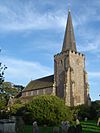 |
West Tarring 50°49′29″N 0°23′45″W / 50.8247°N 0.3958°W |
Anglican | II* | West Tarring's partly 13th-century parish church, in the Early English style, has Italian mosaic designs by William Butterfield in 1885, when a major restoration took place. Its longstanding ecclesiastical status as a peculier of Canterbury Cathedral may have influenced its design. | |
| Christ Church (More images) |
 |
Worthing 50°48′48″N 0°22′25″W / 50.8132°N 0.3737°W |
Anglican | II* | Worthing's second Anglican church, built in 1840–1843 as a chapel of ease to Broadwater and parished in 1855, was reprieved from closure in 2006. The flint building also uses artificial stone—an early example of this. The chancel was altered in 1894, when a hammerbeam roof—likened to Bryant and May matchsticks by Harry Stuart Goodhart-Rendel—was added. | |
| St Symphorian's Church (More images) |
 |
Durrington 50°50′11″N 0°24′48″W / 50.8364°N 0.4133°W |
Anglican | II | The ancient parish church was wrecked during the English Civil War, and remained disused until Lacy W. Ridge built a new structure incorporating its remains. It opened in 1916 and was extended (with a chancel) in 1941. | |
| St George's Church (More images) |
 |
East Worthing 50°48′51″N 0°21′26″W / 50.8142°N 0.3573°W |
Anglican | II | George Truefitt's Bargate stone, Decorated Gothic-style church was consecrated in 1868 and extended in 1875 and 1884. The chancel and adjacent aisle have large apses, and there is a bell-tower with a spirelet. The interior was refitted in 1990–91. | |
| St Botolph's Church (More images) |
 |
Heene 50°48′49″N 0°23′12″W / 50.8136°N 0.3867°W |
Anglican | II | The ancient chapel at Heene was ruined by the 18th century and partly dismantled in 1766. A fragment remains near the present church flint and stone church, built in the Early English style in 1873 by Edmund Scott and enlarged in 1905. | |
| St John the Divine Church (More images) |
 |
West Worthing 50°48′53″N 0°24′01″W / 50.8147°N 0.4004°W |
Anglican | II | In 1937, N.F. Cachemaille-Day built a brick and flint church to replace a mission chapel linked to St Botolph's. This building of 1900 was incorporated into the new structure, which was extended in 1965 when the short, broad tower and spire were added. | |
| St Andrew the Apostle's Church (More images) |
 |
Worthing 50°48′55″N 0°22′39″W / 50.8153°N 0.3774°W |
Anglican | II | Worthing's first "High Church" Anglican church was so controversial that it stood unused for six years while liturgical differences were thrashed out. Arthur Blomfield's Early English church, eventually consecrated in 1888, uses flint and stonework extensively. | |
| Queen Street Church Centre (More images) |
 |
Broadwater 50°49′26″N 0°22′34″W / 50.8240°N 0.3760°W |
Anglican | – | This combined church and community centre was built in 1993–1994 on the site of the former Broadwater Mission Hall, administered from St Mary's Church. The present church is part of St Mary's parish. | |
| St Stephen's Church |  |
East Worthing 50°49′23″N 0°21′37″W / 50.8231°N 0.3604°W |
Anglican | – | Between 1929 and 1959, this was a mission chapel to St Mary's Church in Broadwater; but it was consecrated in 1959 and became a separate church in its own right. It remains within the parish of St Mary's. | |
| All Saints Church (More images) |
 |
Findon Valley 50°51′01″N 0°23′45″W / 50.8504°N 0.3959°W |
Anglican | – | A church hall, erected in 1936, was used for services in this interwar housing estate until Leonard Keir Hett's brick church of 1956 was consecrated on 22 February of that year. The congregation chose the dedication. The church was parished in 1989, and St Peter's Church at High Salvington was added to the parish in 2010. | |
| St Laurence's Church (More images) |
 |
Goring-by-Sea 50°48′32″N 0°24′27″W / 50.8090°N 0.4074°W |
Anglican | – | Part of the parish of Goring-by-Sea, this church was founded in 1936. An attached hall was added in 1962. The interior has a 15th-century altarpiece retrieved from St Mary's Church, Slaugham. | |
| St Peter's Church (More images) |
 |
High Salvington 50°50′55″N 0°24′29″W / 50.8485°N 0.4081°W |
Anglican | – | The vicar of St Symphorian's Church paid for a tin tabernacle to be erected in High Salvington in 1928. It was part of St Symphorian's parish between 1951 and 2010—since when it has been linked to All Saints Church at Findon Valley—and is Worthing's only iron church. | |
| St Richard's Church (More images) |
 |
Maybridge 50°49′16″N 0°25′06″W / 50.8210°N 0.4183°W |
Anglican | – | This postwar housing estate north of Goring-by-Sea received a permanent church in 1966, when Romilly Craze's brick building opened. A church hall designed by John Leopold Denman had accommodated services since 1954. A parish was created in 1980. | |
| St Matthew's Church (More images) |
 |
Worthing 50°49′04″N 0°22′59″W / 50.8179°N 0.3830°W |
Anglican | – | R.S. Hyde's Early English-style church has an apse and a narrow flèche, and uses locally quarried flint. It was built in 1899 and extended with vestries and aisles in 1911. | |
| Broadwater Baptist Church (More images) |
 |
Broadwater 50°49′37″N 0°21′53″W / 50.8270°N 0.3648°W |
Baptist | – | R.W. Brough's 1968 brick structure is the successor to a church hall used since 1937 by Broadwater's Baptist community, which had first met in 1881 in a former stable. Another building, registered as Baptist School Chapel, on a site on nearby Penfold Road was also used between 1904 and 1937. | |
| East Worthing Baptist Church (More images) |
 |
East Worthing 50°48′56″N 0°21′09″W / 50.8156°N 0.3525°W |
Baptist | – | In 1933, an Evangelical community founded a church in East Worthing; it was opened by Worthing's mayor the following year. The Baptist Church acquired the building, a brick structure designed by T.R. Hyde, in 1946. As East Worthing Evangelical Free Church it was registered for worship in December 1934; it was re-registered for Baptists in January 1947. | |
| Findon Valley Free Church (More images) |
 |
Findon Valley 50°50′51″N 0°23′48″W / 50.8475°N 0.3966°W |
Baptist | – | The present octagonal-shaped building was designed by R.W. Brough in 1958 and registered in October of that year, but this church has its origins in a church founded by Worthing Baptist Church in Findon in 1906, before the Findon Valley estate existed. It moved to a wooden building there in 1939. | |
| West Worthing Baptist Church (More images) |
 |
West Tarring 50°49′12″N 0°23′33″W / 50.8199°N 0.3926°W |
Baptist | – | The present building is in three linked parts: Resta Moore's original "school chapel" of 1900, which superseded a hall used by the Baptist community since 1890; Norman Myers's 1938 extension; and an adjacent community and social centre completed in 1988. The church was registered in July 1938, replacing the original building. | |
| Worthing Baptist Church (More images) |
 |
Worthing 50°48′57″N 0°22′31″W / 50.8159°N 0.3752°W |
Baptist | – | Worthing's first permanent Baptist place of worship opened on this site in 1881. Resta Moore built an extension of brick and flint four years later, and two more enlargements followed as the church's popularity grew. Its members helped to establish several Baptist churches within and outside Worthing. The church was registered for the solemnisation of marriages in April 1886. | |
| Worthing Tabernacle (More images) |
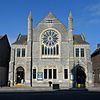 |
Worthing 50°48′53″N 0°22′16″W / 50.8148°N 0.3712°W |
Evangelical | II | James Lund's pale stone and dark brick building blends the Gothic and Romanesque Revival styles and has a distinctive rose window. It was built in 1908 to accommodate the Evangelical congregation who had previously worshipped at the Montague Street Tabernacle Chapel (built in 1839), and was registered in July of that year. | |
| Maybridge Community Church (More images) |
 |
Maybridge 50°49′08″N 0°25′07″W / 50.8188°N 0.4186°W |
Evangelical | – | Founded in 1954 on the Maybridge housing estate, this Evangelical church is associated with the Worthing Tabernacle. The original structure, part of a former hospital, was rebuilt here; it has since been extended. As Maybridge Evangelical Free Church it was registered for worship in February 1955 and for marriages in February 1969. | |
| West Worthing Evangelical Church (More images) |
 |
West Worthing 50°48′58″N 0°23′55″W / 50.8162°N 0.3985°W |
Evangelical | – | James Lund, designer of the Worthing Tabernacle, adopted a different design—the Queen Anne style—for this church of 1912, built to serve an Evangelical community who had worshipped at a private house since 1900. | |
| River of Life Church | 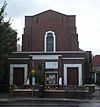 |
Worthing 50°49′18″N 0°22′25″W / 50.8216°N 0.3735°W |
Evangelical | – | This Art Deco building was used by Christian Scientists between 1939 and 1987; it replaced a 1921 structure on the same site. After that congregation moved to West Worthing, the church was acquired by a congregation planted out of the New Life Church at Durrington. Under the name Oasis Centre, it was registered for worship and for marriages in May 1993, and it has also had the name Broadwater Christian Fellowship. | |
| Clifton Community Church (More images) |
 |
Worthing 50°48′59″N 0°22′42″W / 50.8164°N 0.3782°W |
Evangelical | – | This Gothic-style stone and brick church has been used by several religious groups, including Baptists and Brethren, since it opened in 1905, and has undergone many changes of name. Its present status is Evangelical. | |
| St Mary of the Angels Church (More images) |
 |
Worthing 50°48′48″N 0°22′38″W / 50.8132°N 0.3773°W |
Roman Catholic | II | Henry Clutton's brick and Portland stone French Gothic-style church—Worthing's oldest public place of Roman Catholic worship—was opened in 1864 and completed in 1939 when Frederick Walters added a chancel. | |
| Church of the English Martyrs (More images) |
 |
Goring-by-Sea 50°48′57″N 0°25′40″W / 50.8158°N 0.4277°W |
Roman Catholic | – | The concrete church opened in 1968 to replace Jupp's Barn, the former barn of Jupp's Farm, which dated from 1771: this had been converted into a church in 1934 and registered in 1952. It is now the church hall. In the present "utilitarian concrete" church, parishioner Gary Bevans painted a scale replica of the Sistine Chapel ceiling on the ceiling between 1988 and 1993. | |
| St Michael's Church (More images) |
 |
High Salvington 50°50′31″N 0°24′18″W / 50.8419°N 0.4049°W |
Roman Catholic | – | This church moved to its present location in 1966 from Durrington, where the parish was formed in 1927 and a chapel was erected in 1938. The modernist design "departs from any conventionality" according to English Heritage. It was registered for worship and for marriages in October 1966. | |
| Offington Park Methodist Church (More images) |
 |
Broadwater 50°49′44″N 0°22′51″W / 50.8290°N 0.3808°W |
Methodist | – | The Wesleyan Methodist community acquired this site in 1928; the first church was opened in 1932 and was registered in October that yar, but it was replaced in 1958 with a new 400-capacity brick structure by architect Graeme Highet. The new building was registered in March 1959. Additions were made in the grounds in the 1970s. | |
| Goring Methodist Church (More images) |
 |
Goring-by-Sea 50°48′49″N 0°25′48″W / 50.8135°N 0.4301°W |
Methodist | – | Methodist worship in Goring-by-Sea started in a local hall in 1945, and a permanent church was built six years later by John Leopold Denman. The long, low brick building has a small bronze spire. It was registered for worship in March 1951 and for marriages in April 1952. | |
| Goring United Reformed Church (More images) |
 |
Goring-by-Sea 50°48′58″N 0°24′37″W / 50.8162°N 0.4102°W |
United Reformed Church | – | World War II delayed the construction of this church for 11 years until 1949; a school was used for worship instead. The building, which was registered in April 1949, became the church hall in 1961 when a new church, in brick and concrete and with exterior walls forming a series of V-shapes, opened. | |
| Emmanuel United Reformed Church (More images) |
 |
Heene 50°48′44″N 0°23′10″W / 50.8122°N 0.3860°W |
United Reformed Church | – | Founded in 1926 as St Columba's Presbyterian Church, the original church (registered in 1932) became the church hall in 1937 when it was replaced by an Art Deco structure with a tower and variegated brickwork to the design of Frederic Lawrence. St Columba's and Shelley Road United Reformed Churches united in 2005 when the building in Shelley Road was closed. | |
| Worthing Christadelphian Church (More images) |
 |
Worthing 50°49′00″N 0°22′42″W / 50.8167°N 0.3783°W |
Christadelphians | – | This community worships in a church used between 1961 and 1969 by Theosophists, who had a presence in Worthing from 1924. The structure was altered in 1989. It was registered for marriages by Christadelphians in September 1971. | |
| St Demiana and Pope Kyrillos VI Coptic Orthodox Church (More images) |
 |
Worthing 50°48′42″N 0°21′59″W / 50.8118°N 0.3664°W |
Coptic Orthodox | – | Architect John Wills was commissioned to build a replacement for the Bedford Row Methodist Chapel; his Early English style building, in rag-stone and featuring a corner tower, was completed in 1899 and opened in 1900. The church was reprieved from closure in 2003, at which time it was called Steyne Gardens Methodist Church, but it was announced in July 2015 that it would close at the end of August that year (by which time it had been renamed Cornerstone Methodist Church). It was bought by the Coptic Orthodox Church in Britain and Ireland in 2017 and opened the following year. | |
| Christian Brethren Hall (More images) |
 |
West Worthing 50°49′04″N 0°23′42″W / 50.8178°N 0.3951°W |
Exclusive Brethren | – | This small hall, built and registered in 1934 but given its present appearance by a 1950s remodelling, is the only extant Brethren place of worship in Worthing; three others are no longer used. It is part of the Exclusive Brethren movement which separated from what is now the Plymouth Brethren Christian Church in 1970. | |
| Kingdom Hall (More images) |
 |
West Worthing 50°49′03″N 0°23′43″W / 50.8175°N 0.3953°W |
Jehovah's Witnesses | – | This opened in 2015 on the site of the former Second Church of Christ, Scientist in Grand Avenue near West Worthing railway station. The purpose-built Kingdom Hall replaced a converted house on nearby South Street which had been the fifth Jehovah's Witnesses place of worship in Worthing since the denomination was established locally in 1922. The new building was registered for marriages in July 2015. | |
| Church of Jesus Christ of Latter-day Saints, Worthing Chapel |  |
Goring-by-Sea 50°49′06″N 0°25′59″W / 50.8182°N 0.4330°W |
Latter-day Saint | – | The congregation, whose first meetings were held in 1964, numbered more than 300 by the 1980s, so a permanent church was built. The brick building opened in 1984 and was registered for worship and for marriages in August of that year. | |
| Elim Church Worthing |  |
Worthing 50°49′15″N 0°22′21″W / 50.8208°N 0.3725°W |
Pentecostal | – | Since the Elim Tabernacle in Grosvenor Road closed in 1982, the Pentecostal community has used several venues, including this converted house on Broadwater Road. | |
| Friends Meeting House (More images) |
 |
West Worthing 50°48′52″N 0°23′46″W / 50.8144°N 0.3962°W |
Quaker | – | Quakers first met in Worthing in the 1920s and were peripatetic until 1945, when a private house was registered. In 1958 they opened their own meeting house behind Mill Road, bought the previous year for £7,000, and registered it in January 1958. The building was originally a garage and boathouse. The premises have been shared with Spiritualists, Unitarians and others at various times. | |
| Salvation Army Citadel (More images) |
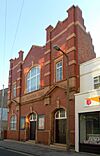 |
Worthing 50°48′37″N 0°22′36″W / 50.8104°N 0.3766°W |
Salvation Army | – | The Army has a controversial history in Worthing: their arrival in 1883 caused riots, led by a mob called the Skeleton Army. Peaceful relations had been established by the time a permanent citadel replaced temporary barracks accommodation in 1912. The building was registered in 1919. | |
| Worthing Spiritualist Church (More images) |
 |
Worthing 50°48′46″N 0°22′26″W / 50.8128°N 0.3738°W |
Spiritualist | – | This Art Nouveau-influenced building, designed by a local architect, was opened for worship by Sir Arthur Conan Doyle in 1926, although it was built earlier. Its original name, under which it was registered in April 1926, was Spiritualist Mission Church. | |
| Masjid Assalam (More images) |
 |
Worthing 50°49′09″N 0°22′12″W / 50.8193°N 0.3700°W |
Sunni Islam | – | Worthing's mosque doubles as a cultural and social centre for the local Muslim population. An early-morning arson attack in 2005 caused substantial damage, but the building has been repaired. The mosque, which was registered in March 1995, had more than 1,000 worshippers in 2003. |
Former places of worship
| Name | Image | Location | Denomination/ Affiliation |
Grade | Notes | Refs |
|---|---|---|---|---|---|---|
| Holy Trinity Church (More images) |
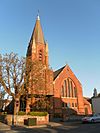 |
Worthing 50°48′41″N 0°22′43″W / 50.8113°N 0.3786°W |
Anglican | II | Late 19th-century housing development in the Gratwicke area west of the town centre resulted in the building of this church in 1882–1883. It was parished almost immediately. Henry Coe and S. Robinson's Early English design, in dark red brick, lacked the present tower; this was added in 1888. The church has been disused and empty since 2014. | |
| St Paul's Church (More images) |
 |
Worthing 50°48′49″N 0°22′17″W / 50.8137°N 0.3714°W |
Anglican | II | An 1809 Act of Parliament allowed St Paul's to be built as a chapel of ease to St Mary's Church in Broadwater; it remained in force until 1893, when a parish was formed. It thrived as Worthing's reputation as a fashionable seaside resort grew, and the sale of pews to visitors brought in much money. John Rebecca's stuccoed brick building with Doric columns and cupola became structurally unsound and was closed in 1995. | |
| Anglesea Street Mission |  |
Worthing 50°49′01″N 0°22′44″W / 50.8169°N 0.3789°W |
Anglican | – | Christ Church's first mission hall was opened in the 1880s, originally under the name Clifton Road Mission Hall. Under its present name, Verrall Hall, it is a Scout headquarters. | |
| Crescent Road Mission (More images) |
 |
Worthing 50°48′37″N 0°22′34″W / 50.8102°N 0.3761°W |
Anglican | – | Originally a non-denominational mission chapel, this was taken over by Christ Church and used as a mission hall. It is now part of an adjacent shop. | |
| Newland Road Mission (More images) |
 |
Worthing 50°49′06″N 0°22′07″W / 50.8184°N 0.3686°W |
Anglican | – | Built in 1883 by St George's Church to serve new housing near the railway, this red-brick chapel, designed by George Hewer, was used until 1936. Under the new guise of Forester's Hall, it has been a school and a photographic studio. | |
| Ham Arch Mission |  |
East Worthing 50°49′10″N 0°21′14″W / 50.8194°N 0.3538°W |
Anglican | – | Named after a nearby railway bridge, and ironically known as "The Cathedral" locally, this tiny hut—now a workshop—was served from St George's Church for 29 years from 1885. | |
| Bedford Row Methodist Chapel (More images) |
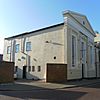 |
Worthing 50°48′41″N 0°22′08″W / 50.8114°N 0.3690°W |
Methodist | II | Worthing's first Wesleyan Methodist chapel, the Providence Chapel of 1822, was replaced by this pedimented, stuccoed, Neoclassical building, with tall, tapering windows, in 1840. It passed into secular use in 1900 when the church in Steyne Gardens (now Cornerstone Methodist Church) replaced it, and is now the function room of the Vintners Parrot pub. | |
| Lyndhurst Road Methodist Church (More images) |
 |
East Worthing 50°49′01″N 0°21′20″W / 50.8169°N 0.3556°W |
Methodist | – | An iron chapel for Primitive Methodists opened in Chapel Road in 1880, moved to Lyndhurst Road in 1893 and was superseded by H.K. Armitage's Perpendicular Gothic church in 1929. The Methodist Church declared it redundant in 2005, and permission was granted to establish a children's centre in it. | |
| Methodist Providence Chapel (More images) |
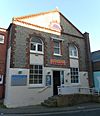 |
Worthing 50°48′39″N 0°22′09″W / 50.8109°N 0.3691°W |
Methodist | – | This chapel was built in 1822 in a Neoclassical style using flint cobblestones on the exterior. After the new chapel in nearby Bedford Row was built in 1840, it was unused until 1852, when an independent Christian group took it on. It was subsequently registered by the Old Baptist Union between 1896 and 1906. The building now houses a youth club. | |
| Tarring Road Methodist Church (More images) |
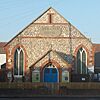 |
Worthing 50°49′04″N 0°22′46″W / 50.8179°N 0.3795°W |
Methodist | – | This Wesleyan chapel, completed in 1884, cost £735 (£55,000 as of 2025). The brick and flint building was designed by R. Hollands. Latterly known as Cornerstone Hall, its registration for marriages and worship was cancelled in August 2015, and it is now a Montessori nursery school. | |
| Montague Street Tabernacle Chapel | 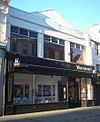 |
Worthing 50°48′37″N 0°22′15″W / 50.8104°N 0.3707°W |
Independent | – | This 1839 building had many uses (hall, theatre, temporary church) until 1888, when it became the non-denominational Worthing Free Church. The Worthing Tabernacle was founded in 1895, and the building was re-registered under that name the following year. It moved to its new premises in 1908, after which it was renamed St James's Hall and used as an entertainment venue. It is now a shop. | |
| New Street Chapel | 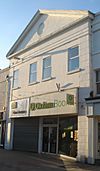 |
Worthing 50°48′36″N 0°22′32″W / 50.8101°N 0.3755°W |
Independent | – | This was built in the Classical style in 1861 for Independent Evangelicals to the design of Charles Hide. It declined after its founder, John Adams, died, and closed in 1906. The building, including the prominent pediment, survives behind a shop façade. | |
| Bedford Row Gospel Hall (More images) |
 |
Worthing 50°48′37″N 0°22′08″W / 50.8103°N 0.3688°W |
Open Brethren | – | This stuccoed building of around 1850 was in religious use by 1908, when it was registered by the Old Baptist Union. They moved out in 1928 and Open Brethren took it on. From 1977 it was described as an Evangelical church. It has fallen out of use and is unoccupied as of 2025. | |
| Brethren Gospel Hall | 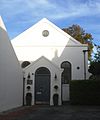 |
West Tarring 50°49′31″N 0°23′35″W / 50.8253°N 0.3931°W |
Open Brethren | – | This tiny chapel, now in residential use, is set back from Tarring's ancient high street. It is in a simple Classical style with a pediment and oeil de boeuf. Services were held from 1860 until 1992, although the premises were not formally registered until May 1923 (with the name Tarring High Street Chapel). | |
| Elim Tabernacle (More images) |
 |
Worthing 50°48′49″N 0°22′25″W / 50.8135°N 0.3737°W |
Elim Pentecostal | – | George Jeffreys, founder of the Elim Pentecostal Church in the United Kingdom, established this church in 1931. The small building, opposite Christ Church, was registered for worship in May 1932 and was used until 1982; a nursery school now occupies it. | |
| St James's Evangelical Free Church | 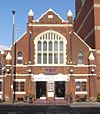 |
Worthing 50°48′45″N 0°22′03″W / 50.8124°N 0.3674°W |
Evangelical | – | T.H. Winney's Perpendicular-style building was used as an Evangelical church from 1926 until 1988, when it became a restaurant and bar. Its original name, under which it was registered between 1926 and 1949, was St James's Hall in reference to the building in Montague Street where the congregation previously met, although when its registration was finally cancelled in February 1989 it was called Worthing Evangelical Free Church. | |
| Kingdom Hall |  |
West Tarring 50°49′16″N 0°23′32″W / 50.8211°N 0.3922°W |
Jehovah's Witnesses | – | This converted house was the fifth Jehovah's Witnesses place of worship in Worthing. The denomination, which was first established in the town in 1922, registered it in 1980. It was used by three Worthing-based Congregations of Jehovah's Witnesses: Broadwater, Durrington and Tarring. In 2013, a planning application was submitted to construct a purpose-built Kingdom Hall on the site of the disused Second Church of Christ, Scientist on nearby Grand Avenue. This was approved, building work was completed in 2015, and the old building's marriage registration was cancelled in July 2015. | |
| Gospel Hall (More images) |
 |
Durrington 50°49′58″N 0°24′46″W / 50.8327°N 0.4127°W |
Plymouth Brethren Christian Church | – | Planning permission for this meeting hall on Birkdale Road was granted in 1990. It had a capacity for about 60 worshippers and was part of the Plymouth Brethren Christian Church. In June 2011 the charity Scope stated that they had "recently" bought it and converted it into a social and activity centre. Now, with the name Ashdown Club, it is now used for similar purposes by the charity Guild Care. | |
| St Charles Borromeo Church (More images) |
 |
East Worthing 50°49′15″N 0°21′17″W / 50.8208°N 0.3546°W |
Roman Catholic | – | A dolphin sculpture above the door of this Neo-Romanesque, cruciform, artificial Cotswold stone church alludes to the earlier use of the Dolphin Inn for services. Henry Bingham Towner's building opened in 1962 and was registered in April of that year. It closed at the start of the COVID-19 pandemic, and in June 2021 the Diocese of Arundel and Brighton decided to sell the church and its site for redevelopment and combine the remaining churches in Worthing and Lancing into one parish. | |
| Ebenezer Strict Baptist Chapel (More images) |
 |
Worthing 50°48′46″N 0°22′22″W / 50.8129°N 0.3729°W |
Strict Baptist | – | In 2005, planning permission was granted for the conversion of this Strict Baptist chapel into a house. The congregation formed in 1887 worshipped elsewhere until 1907, when the chapel was built. It was registered for worship six years later. | |
| Shelley Road United Reformed Church (More images) |
 |
Worthing 50°48′40″N 0°22′29″W / 50.8112°N 0.3746°W |
United Reformed Church | – | This brick and terracotta Early English-style building served the Congregational (later United Reformed Church) community from 1903 until 2005, when the congregation moved to the renamed Emmanuel Church—formerly St Columba's. Its registrations for worship and marriages, granted in November 1903, were cancelled in January 2006. |
See also
- Listed buildings in Worthing
- List of demolished places of worship in West Sussex

